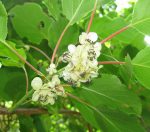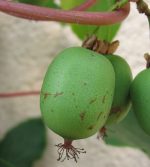 Also known as tara vine, this deciduous woody climber is native to woodlands, mountainous forests, and streamsides of Japan, Korea, nothern China and far eastern Russia, and is a member of the Chinese gooseberry family, Actinidiaceae. Rapidly growing up 30+’ long, this twining vine can climb into trees or on garden sturctures such as a sturdy trellis. The broad ovate leaves are dark green and 3-5″ long. Clusters of male and female greenish-white flowers appear in early summer on different plants and are 3/4″ long and scented. Fertilized female flowers give way in the fall to green grape-sized, edible fruits that are up to 1 1/4″ long and have a smooth leathery skin. These fruits are sweeter than the kiwi fruits commercially available and do not need to be peeled. Plants are grown for both the foliage and fruit. The genus name, Actinidia, comes from the Greek word aktis meaning ray and refers to the way the vine grows which resembles the spokes of a wheel. The specific epithet, arguta, is the Latin word meaning sharp, and refers to to the toothed margins of the leaves.
Also known as tara vine, this deciduous woody climber is native to woodlands, mountainous forests, and streamsides of Japan, Korea, nothern China and far eastern Russia, and is a member of the Chinese gooseberry family, Actinidiaceae. Rapidly growing up 30+’ long, this twining vine can climb into trees or on garden sturctures such as a sturdy trellis. The broad ovate leaves are dark green and 3-5″ long. Clusters of male and female greenish-white flowers appear in early summer on different plants and are 3/4″ long and scented. Fertilized female flowers give way in the fall to green grape-sized, edible fruits that are up to 1 1/4″ long and have a smooth leathery skin. These fruits are sweeter than the kiwi fruits commercially available and do not need to be peeled. Plants are grown for both the foliage and fruit. The genus name, Actinidia, comes from the Greek word aktis meaning ray and refers to the way the vine grows which resembles the spokes of a wheel. The specific epithet, arguta, is the Latin word meaning sharp, and refers to to the toothed margins of the leaves.
 Type: Deciduous woody vine
Type: Deciduous woody vine
Bloom: Clusters of greenish-white male and female flowers in early summer
Size: 25-30′ H x 7-20′ W
Light: Full sun to part shade
Soil: Average,medium moist, well-drained, acidic
Hardiness: Zones 3-8
Care: Prune in summer to restrain, in winter to encourage fruit production.
Pests and Diseases: Phytophora crown and root rot, botrytis rot, sclerotinia blight, root now nematode, two spotted spider mitte, leaf roller, thrip, Japanese beetle, cats (they dig up the roots looking for the source of the catnip-like scent)
Propagation: Seed with 2-3 months cold stratification; cuttings, grafting, layering
Outstanding Selections: ‘Issai’ (smaller than species and self-pollinating)
Photo Credits:Wikipedia